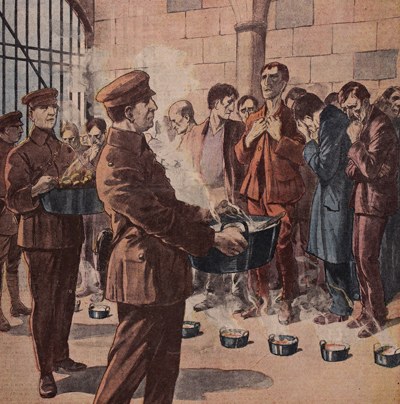Thousands join hunger strikes across Irish prison system
Government takes hard-line and refuses to contemplate political prisoner releases
Dublin, 30 October 1923 - About 8,500 prisoners are now believed to be on hunger strike across the Free-State’s crisis-afflicted prisons.
The spread of the hunger strikes inside the prisons has also led to protests and demonstrations outside. Speaking at a meeting outside Mountjoy where the release of all the prisoners was demanded, Maud Gonne MacBride declared that should one prisoner die, she would herself go on hunger strike until their release was realised. Macbride urged other mothers to join with her, if needed, in starting a hunger strike on the doorsteps of Free State Ministers.
The Free State government has nevertheless been unyielding in the face of the looming prison crisis. Speaking last week in Dublin, President Cosgrave insisted that there would be no unconditional release of prisoners and that those in jail were there because neither life nor property was safe when they were at large.
President Cosgrave also claimed that the ‘hunger- strike’ was a fraud, alleging that brown bread and pastilles had been found in the pockets of some prisoners. At the same time, and somewhat in contradiction with this claim, Mr. Cosgrave declared that should a prisoner die, it would be his own fault and not the Government’s.
This view has been more recently echoed by the Minister for Home Affairs, Mr. Kevin O’Higgins who has insisted that prisoners should not be allowed to use the weapon of hunger-strike to challenge the fabric of the State and those who did must reap the full consequences.
In recent days, however, the Government has indicated that 1,493 prisoners have come off hunger strike. According to information supplied by the Ministry of Defence, these prisoners abandoned the strike on October 27th and 28th, 73 of them in Cork, 1,360 in Tintown A Camp and 20 each in Gormanstown and Newbridge.
These developments have served, it appears, to underscore the Government’s firm response to the hunger strike. Indeed, reacting to a telegram from Cork Corporation urging the Government to ‘take immediate steps for the liberation of all political prisoners, in the interests of peace and good feeling in the country’, General Mulcahy, Minister of Defence, said that the Corporation should consider its duty to provide ‘more serious-minded and effective assistance’ towards achieving these ends than simply sending ‘unreasoned telegrams.’
In an effort to break the impasse, trade unionist Jim Larkin, has written to President Cosgrave calling for a conference to be held today to find ‘a basis of understanding and agreement that will ensure a condition of settled peace in the country.’ The suggestion, The Irish Times reports this morning, has already been dismissed by President Cosgrave who questioned Mr. Larkin’s power and capacity to promote industrial and political peace in Ireland and accusing him of attempting to ‘complicate a dispute about wages with a large political issue affecting the safety and stability of the whole country.’
[Editor's note: This is an article from Century Ireland,
a fortnightly online newspaper, written from the perspective
of a journalist 100 years ago, based on news reports of the
time.]





















